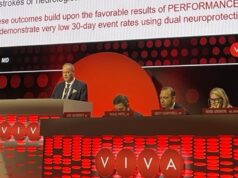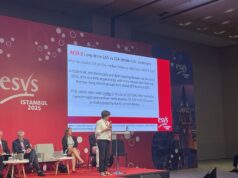
Adham Elmously (New York Presbyterian Hospital, New York, USA) presented outcomes of early transcarotid artery revascularisation (TCAR) versus carotid endarterectomy (CEA) after acute neurologic events during the opening day of the Vascular Annual Meeting (VAM; 15–18 June, Boston, USA).
Speaking on behalf of senior author Danielle Bajakian (Columbia University Medical Center, New York, USA) and colleagues, Elmously concluded that TCAR within 14 days of a neurologic event results in higher ipsilateral postoperative stroke rates when compared to CEA, especially when performed within 48 hours.
Elmously and colleagues state that carotid revascularisation within 14 days of a neurologic event is recommended by society guidelines. They note that TCAR carries the lowest overall stroke rate for any carotid artery stenting technique, but stress that “outcomes of TCAR within 14 days of a neurologic event have not been studied or directly compared to CEA”.
The research team compared in-hospital outcomes of symptomatic patients undergoing TCAR and CEA within 14 days of stroke or transient ischaemic attack (TIA) from January 2016 to February 2020 using the Society for Vascular Surgery (SVS) Vascular Quality Initiative (VQI) carotid artery stenting and CEA databases.
They note that propensity score matching was used to adjust for patient risk factors, and that the primary outcome was a composite of postoperative ipsilateral stroke, death and myocardial infarction (MI). The researchers detail that 1,281 symptomatic patients underwent TCAR and that 13,429 patients underwent CEA within 14 days of a neurologic event. After 1:1 propensity matching, they add, 728 matched pairs were included for analysis.
At VAM, Elmously communicated that the primary composite outcome of stroke, death or MI was more frequent in the TCAR group (4.7% vs 2.6%, p=0.04). The presenter informed delegates that this was driven by a higher rate of postoperative ipsilateral stroke in the TCAR group (3.8% vs 1.8%, p=0.005). In addition, he reported that there was no difference between TCAR and CEA in terms of death (0.7% vs 0.8%, p=0.8) or MI (0.8% vs 1%, p=0.7).
Although TCAR procedures were shorter (69 minutes, interquartile range 53–85 vs 120 minutes, IQR 93–150, p<0.001) and postoperative length of stay was similar (two days, p=0.3) compared to CEA, TCAR patients were more likely to be discharged to a facility other than home (26% vs 18.9%, p<0.01), Elmously detailed. He also said that performing TCAR within 48 hours of a stroke was an independent predictor of postoperative stroke or TIA (odds ratio [OR] 5.4, 95% confidence interval [CI] 1.8–16).











